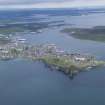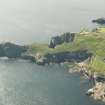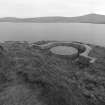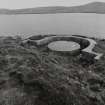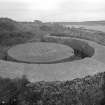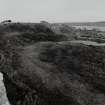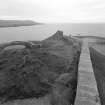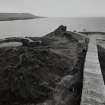Lerwick, The Knab, Coastal Battery
Anti Aircraft Battery (Second World War), Coastal Battery (First World War)
Site Name Lerwick, The Knab, Coastal Battery
Classification Anti Aircraft Battery (Second World War), Coastal Battery (First World War)
Alternative Name(s) Lerwick Defences: "bx" Site
Canmore ID 115447
Site Number HU44SE 91
NGR HU 4794 4049
Datum OSGB36 - NGR
Permalink http://canmore.org.uk/site/115447
- Council Shetland Islands
- Parish Lerwick
- Former Region Shetland Islands Area
- Former District Shetland
- Former County Shetland
HU44SE 91 4794 4049
This battery is situated SE of Lerwick, immediately W of Peerie Geo, at the end of the Knab Road. One gun emplacement and magazine remain. The second gun emplacement has been replaced by the turning circle at the end of the Knab Road. The battery formed part of the Coast Defences of Lerwick.
J Guy 1995; NMRS Ms 810/4, 164-5, 167
The one remaining gun-emplacement of the coast battery survives on the E side of Kanb Road about 37m NE of the turning circle.
The emplacement is circular and built of concrete with a low parapet wall surrounding the circular gun platform. The magazine (HU 47966 40505) is shown on the current OS 1:2500 scale digital map.
The battery is visible on vertical air photographs (106G/Scot/UK 97, 4047-4048, flown 18 May 1946), which show the two gun-emplacements, magazine and hut bases.
Visited by RCAHMS (DE, AL), October 1998
Project (March 2013 - September 2013)
A project to characterise the quantity and quality of the Scottish resource of known surviving remains of the First World War. Carried out in partnership between Historic Scotland and RCAHMS.
Field Visit (25 July 2017)
Situated on the knoll above the surviving First World War gun emplacement is a flat concrete base for a light anti-aircraft gun, a Bofors 40mm. This site codenamed 'BX' is recorded in files (WO 166/2051 and WO 166/2052) dated May 1940 and January 1941, held by the National Archives in Kew, London.
Visited by Historic Environment Scotland (AKK) 25 July 2017
Project
Recording Scotland's graffiti project was designed to review the range of historic and contemporary graffiti art across Scotland. It involved desk-based assessment and fieldwork at a number of example sites, to consider recording methodologies and dissemination practices.
Between 2016 and 2017, phase 1 of the project aimed to:
Aim 1: review a range of historic and contemporary graffiti art from across Scotland, already present in Canmore.
Aim2: undertake a research review of previous approaches to recording graffiti art in Canmore and other HERs, review and develop the current Thesaurus terms.
Aim 3: test and develop a range of recording methods within the following programmes or projects: Discovering the Clyde programme (1223), Scotland’s Urban Past (1222), Architecture and Industry projects, such as Urban Recording Projects (1028), Area Photographic Survey (311) and the Tomintoul and Glenlivet Landscape Partnership (1167).
Aim 4: the following test sites will be considered for research into the range of historic and contemporary graffiti. They will be analysed to demonstrate the different ages, contexts, styles and survivals of historic and contemporary graffiti: Polphail village (Canmore ID 299112), Scalan farmstead (170726), Cowcaddens Subway Station (243099), Croick Parish Church (12503), Dalbeattie Armament Depot (76279) and Dumbarton Rock (43376).
Aim 5: to research the potential for social media to play a role in crowd-sourcing information and archiving Scotland’s graffiti art.
In 2017-2019, phase 2 of the project aimed to:
Aim 1: To enhance the NRHE to the point at which it can be said to adequately represent the broad range of historic and modern graffiti that is evident throughout Scotland, and to explore ways by which that information can best be disseminated.
Aim 2: To develop guidelines that will convey the HES approach to researching and recording graffiti.
Aim 3: To write a specification for a book on Scotland’s graffiti.
Aim 4: To develop external partnerships to explore further ways to record graffiti and to identify and explore potential funding streams to enable further knowledge exchange and research.
The project was managed by Dr Alex Hale, with contributions from staff across Herirtage and Commercial and Tourism directorates.

















